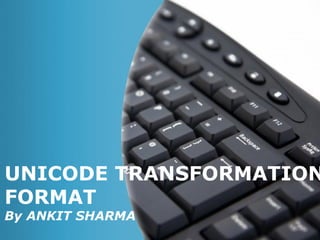
Unicode
- 1. UNICODE TRANSFORMATION FORMAT By ANKIT SHARMA Page 1
- 2. INTRODUCTION • Computers at their most basic level just deal with numbers. They store letters, numerals and other characters by assigning a number for each one. • �In the pre-Unicode environment, we had single 8-bit characters sets, which limited us to 256 characters max. No single encoding could contain enough characters to cover all the languages. • �so hundreds of different encoding systems were developed for assigning numbers to characters. Page 2
- 3. Cnt… • As a result, these coding systems conflict with each other. That is, two encodings can use the same number for two different characters or different numbers for the same character. • �Any given computer needs to support many different encodings. • �yet whenever data is passed between different encodings or platforms, that data always runs the risk of corruption. Page 3
- 4. examples of character encoding systems • examples of character encoding systems • Morse code, • Baudot code, • the American Standard Code for Information Interchange (ASCII) • Unicode. Page 4
- 5. WHAT IS UNICODE ? Unicode provides a unique number for every character, no matter what the platform, no matter what the program, no matter what the language. The Unicode Standard is a character coding system designed to support the worldwide interchange, processing, and display of the written texts of the diverse languages. Page 5
- 6. From ASCII to Unicode • �Most character sets and encodings in 70s/80s were modifications or extensions of ASCII • �Most common encodings now a days use single byte per character (SBCS) • �They are all limited to 256 characters • �Due to that, none of them can even cover the letters for the Western European languages Page 6
- 7. Where is Unicode Used ? • �The Unicode standards has been adopted by many software and hardware vendors. • �Most OSs support Unicode. • �Unicode is required for international document and data interchange, the Internet and the WWW, and therefore by modern standards such as: • �Java, C#, Perl, Python • �Markup languages such as XML, HTML, XHTML, • �JavaScript, LDAP, CORBA etc. Page 7
- 8. UTF-8 • �UTF-8 is the 8-bit encoding of Unicode • �It’s a variable-width encoding and also a strict superset of ASCII. • �“Strict superset” means that every character in ASCII is available in UTF-8 with the same corresponding code point value • �1 character = 1byte to 4 bytes in the encoding • �Characters from European scripts: either 1or 2 bytes • �Asian scripts: 3 or 4 bytes Page 8
- 9. • �UTF-8 used for UNIX-platforms, HTML and most Internet Browsers • �Main benefits of UTF-8 • �compact storage requirements for European scripts • �In general European scripts will occupy less storage on disk and memory • �Ease of migration –since 7-bit ASCII data remains the same in UTF-8, data conversion effort between ASCII based character sets and UTF-8 is reduced significantly. Page 9
- 10. UTF-16 • �UTF-16 is the 16-bit encoding of Unicode • Basically an extension of UCS-2 • �One Unicode character can be 2 or 4 bytes in • �the encoding Characters from European and most Asian scripts are represented in 2 bytes • �Supplementary characters are represented in 4 bytes • �UTF-16 is the main Unicode encoding from Windows 2K Page 10
- 11. • �Main benefits of UTF-16: • �More compact storage requirements for Asian scripts (2 bytes for commonly used characters) • �Ideal if European and Asian scripts are used together • �UTF-16 will occupy less storage on disk and memory than with UTF-8 (3 bytes for Asian part) Balance of efficient access to characters and economical use of storage. Page 11
- 12. UTF-32 • �32-Bit encoding • �Popular when memory space is no concern • �Fixed width (4Byte) Page 12
- 13. Unicode @ the Library • �» Display all scripts and characters • �» Record data in all languages • �» Exchange bibliographic data • �» Search in all languages … Page 13
- 14. THANK YOU Page 14
Notes de l'éditeur
- ANKIT & SUSHEEL
